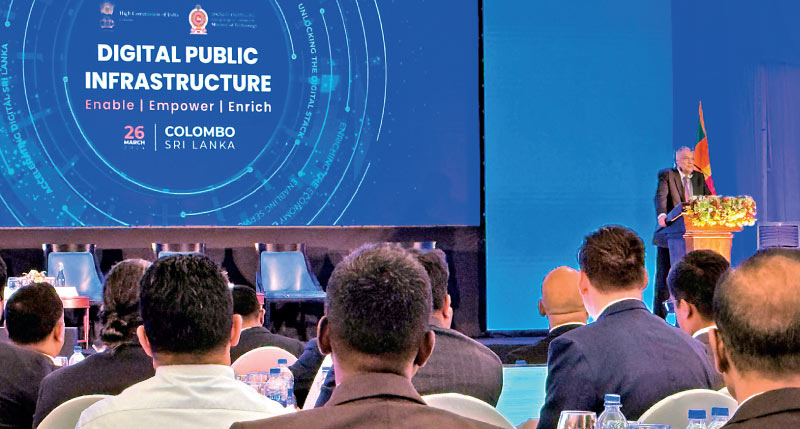Monday Apr 21, 2025
Monday Apr 21, 2025
Thursday, 28 March 2024 01:30 - - {{hitsCtrl.values.hits}}

 Infrastructure development is a fundamental for economic growth. Any country seeking to improve its people’s lives must invest in infrastructure to ensure free and speedy movement of goods and services. Trade and commerce and therefore economic growth depend on such developments.
Infrastructure development is a fundamental for economic growth. Any country seeking to improve its people’s lives must invest in infrastructure to ensure free and speedy movement of goods and services. Trade and commerce and therefore economic growth depend on such developments.
So historically the road to economic heaven has been literally that – building of roads, and other infrastructure for free and easy movement of goods. And this kind of development took years. Sometimes decades before its fruits could be tasted by the common man.
It’s the same in 2024. Except the new road that promises a speedy compressed gateway to economic heaven is also digital. And digital infrastructure building is fast becoming a way of catapulting and accelerating economic development.
Over the last one decade or so India’s digital public infrastructure developments has created unprecedented and positive economic and social change.
Some of these highly accelerated and significant outcomes are credited to the high quality development and execution of India’s digital public infrastructure. The Indian High Commission and the Ministry of Technology, Sri Lanka organised a session in Colombo on 26 March titled – Digital Public Infrastructure. Enable. Empower. Enrich.
This session was held to shed light on India’s digital transformation story and to discuss possible opportunities for Sri Lanka from that.
Pramod Varma, the architect of Aadhar told the story of India’s digital transformation and explained the vision of this continuing story moving forward. And spoke about how Sri Lanka can borrow from India’s learning to accelerate economic growth with DPI (digital public transformation).
The starting point for this revolution, he said, could be traced to India’s ambitious program to create a unique digital identity – the aadhar card – which gives every Indian a verifiable identity – literally a digital fingerprint that can be used securely for online transactions.
Aadhar used a simple API (Application Programming Interface) that is open source and interoperable – its source is code is available for anyone to use and build on and can be modified to work seamlessly with other applications.
Today there are close to 1.2 billion aadhar identities registered in India creating a big eco system of digitally verified people ready to become part of the business ecosystem.
With Aadhar implemented the Government had the public data needed to create the base for the transformation.
Identity was followed by ‘rail setting’ for payments. UPI (Unified Payments Interface) created a digital gateway for seamlessly connecting people with their bank accounts. This meant close to 1.2 billion digitally verified people were technically ready to transact with their accounts too being linked and verified. And they did.
The Indian digital public infrastructure model is a public private partnership – where the government sets up the digital infrastructure (building block API – Application Program Interface) and encourages businesses to build digital solutions on top of these that are easy to access, and works out at a lower cost and in a manner that benefits and reaches all sections of society in India. It’s unique unlike the laissez faire model – where markets dictate the terms and there are chances of monopolistic tendencies and restricted use or unlike the regulatory model – where the State determines the rules and could impede enterprise.
Simply put it ambitiously envisions a digital transformation such that a digitally verified identity linked to a bank account and a registered mobile phone should be able to interact directly and conveniently with all kinds of businesses and services thereby unlocking value for all – for the consumer – reducing the cost and making it convenient and for the service and business – an easy direct and transparent way to deal with their customers and a smart way to run their business.
The potential of DPI goes well beyond uses for commerce. With a well developed digital public infrastructure in place, the Government can now reach large sections of Indian society directly if emergency payments have to be made without the previous issue of leakages of these funds. This has great potential even in critical areas such as health and education. In India the COWIN app was used to disseminate millions of vaccinations during COVID and was thus a life saving measure.
So to summarise – the key requirements based on the India learning is to create database of identities that belongs to the state or to the public entity. These can be shared through open source, interoperable API (Application Program Interface) with private enterprises. Who build on this to unlock value through better offerings of goods and services. And for the state itself to use this data to provide direct financial benefits of health or education services with no leakages or with significantly less inefficiencies.
So the key elements are data, open source interoperable API (Application Program Interface) created by state or public entities and a private sector using this opportunity to build on these with their own digital systems to provide easy to access, efficient and cost effective goods and services to all in the country. The session conducted by the Indian High Commission and the Ministry of Technology, Sri Lanka set the tone and context for Sri Lanka to learn and adapt the Indian model in this country. Sri Lanka needs significant acceleration of their economic growth. And this digital public infrastructure model could be just that – a digital road to economic heaven.
(The writer is an Indian with business in Sri Lanka. He was the first Indian to transact using UPI in Sri Lanka. He can be reached on [email protected].)
Discover Kapruka, the leading online shopping platform in Sri Lanka, where you can conveniently send Gifts and Flowers to your loved ones for any event including Valentine ’s Day. Explore a wide range of popular Shopping Categories on Kapruka, including Toys, Groceries, Electronics, Birthday Cakes, Fruits, Chocolates, Flower Bouquets, Clothing, Watches, Lingerie, Gift Sets and Jewellery. Also if you’re interested in selling with Kapruka, Partner Central by Kapruka is the best solution to start with. Moreover, through Kapruka Global Shop, you can also enjoy the convenience of purchasing products from renowned platforms like Amazon and eBay and have them delivered to Sri Lanka.
Discover Kapruka, the leading online shopping platform in Sri Lanka, where you can conveniently send Gifts and Flowers to your loved ones for any event including Valentine ’s Day. Explore a wide range of popular Shopping Categories on Kapruka, including Toys, Groceries, Electronics, Birthday Cakes, Fruits, Chocolates, Flower Bouquets, Clothing, Watches, Lingerie, Gift Sets and Jewellery. Also if you’re interested in selling with Kapruka, Partner Central by Kapruka is the best solution to start with. Moreover, through Kapruka Global Shop, you can also enjoy the convenience of purchasing products from renowned platforms like Amazon and eBay and have them delivered to Sri Lanka.